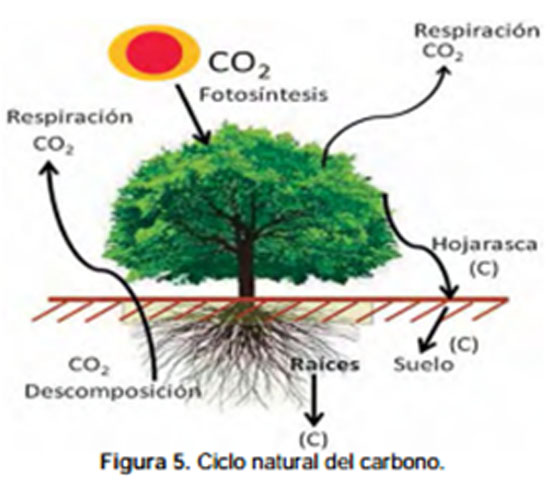Carbon storage in the soil and its relationship with climate change
Abstract
The carbon (C) reserve of the soil is the basic component of its fertility and is considered as an indicator when evaluating the sustainability of cropping systems. Soil fertility and carbon storage are closely linked and should not be considered in isolation. The direct effects on increasing soil organic carbon (SOC) include crop productivity, soil improvement, water and air quality. Furthermore, management practices that increase SOC also tend to reduce erosion and improve soil resources.
References
Albrecht, A. y S. Kandji. 2003. Carbon Sequestration in Tropical Agroforestry Systems: Opportunities and Trade-Offs. Agriculture, Ecosystems & Environment. 99(1-3):15-27.
Bravo, C., Z. Lozano, R. M. Hernández, L. Piñango y B. Moreno. 2004. Efecto de diferentes especies de coberturas sobre las propiedades físicas de un suelo de sabana con siembra directa de maíz. Biogro. 16(3):163-172.
Espinoza, Y. 2012. Efecto de la labranza sobre la materia orgánica y tamaño de agregados en un suelo cultivado con maíz en condiciones tropicales. Bioagro. 22(3):177-184.
Houghton, R. A. 2003. Why are estimates of the terrestrial carbon balances so different? Global Change Biol. 9, 500-509.
MacCracken, M. C. 1985. Carbon dioxide and climate change: Background and overview. pp.1-23. In M.C.MacCraken and F.M. Luther (eds). Projecting the climatic effect of increasing carbon dioxide. U.S. Department of Energy, Er-0237, Washington, D.C.
Nabuurs G. J. y G. M. J. Morhem. 1993. Report IBN 93/4. Institue for Forestry and Research, Forests Nature Absorbing Carbon Dioxide Emission. Holanda . 206 p.
NASA-GISS. 2014. Surface Temperature (GISTEMP) Analyses. In trends: A Compendium of Data on Globsl Change. Carbon Dioxide Information Analysis Center, Oak Ridge National Laboratory, U.S. Department of Energy, Tenn, USA doi:10.3334/CDIAC/cli.001.
Lal, R., J. Kimble, and R.F. Follett. 1997. Pedospheric processes and the carbon cycle.pp.1-8. In R. Lal,
J. Kimble,. R Follett, and B.A. Stewart (eds.) Soil processes and the carbon cycle. CRC Press. Boca Ratón.
Reicosky, D. C. y D. W. Archer. 2007. Moldboard plow tillage depth and short-term carbon dioxide release. Soil and Tillage Research 94:109-121.
Schlesinger, W. H. 1997. Biogeochemistry: An Analysis of Global Change. New York: National Academic Press.
Snyder, C. S., T. W. Bruulsema y T. L. Jensen. 2007. Best management practices to minimize greenhouse gas emissions associated with fertilizer use. Better Crops with Plant Food 91(4):16-18.
Bravo, C., Z. Lozano, R. M. Hernández, L. Piñango y B. Moreno. 2004. Efecto de diferentes especies de coberturas sobre las propiedades físicas de un suelo de sabana con siembra directa de maíz. Biogro. 16(3):163-172.
Espinoza, Y. 2012. Efecto de la labranza sobre la materia orgánica y tamaño de agregados en un suelo cultivado con maíz en condiciones tropicales. Bioagro. 22(3):177-184.
Houghton, R. A. 2003. Why are estimates of the terrestrial carbon balances so different? Global Change Biol. 9, 500-509.
MacCracken, M. C. 1985. Carbon dioxide and climate change: Background and overview. pp.1-23. In M.C.MacCraken and F.M. Luther (eds). Projecting the climatic effect of increasing carbon dioxide. U.S. Department of Energy, Er-0237, Washington, D.C.
Nabuurs G. J. y G. M. J. Morhem. 1993. Report IBN 93/4. Institue for Forestry and Research, Forests Nature Absorbing Carbon Dioxide Emission. Holanda . 206 p.
NASA-GISS. 2014. Surface Temperature (GISTEMP) Analyses. In trends: A Compendium of Data on Globsl Change. Carbon Dioxide Information Analysis Center, Oak Ridge National Laboratory, U.S. Department of Energy, Tenn, USA doi:10.3334/CDIAC/cli.001.
Lal, R., J. Kimble, and R.F. Follett. 1997. Pedospheric processes and the carbon cycle.pp.1-8. In R. Lal,
J. Kimble,. R Follett, and B.A. Stewart (eds.) Soil processes and the carbon cycle. CRC Press. Boca Ratón.
Reicosky, D. C. y D. W. Archer. 2007. Moldboard plow tillage depth and short-term carbon dioxide release. Soil and Tillage Research 94:109-121.
Schlesinger, W. H. 1997. Biogeochemistry: An Analysis of Global Change. New York: National Academic Press.
Snyder, C. S., T. W. Bruulsema y T. L. Jensen. 2007. Best management practices to minimize greenhouse gas emissions associated with fertilizer use. Better Crops with Plant Food 91(4):16-18.

Published
2024-05-10
How to Cite
Espinoza, Y., & Malpica, L. (2024). Carbon storage in the soil and its relationship with climate change. INIA Divulga, 31(31), 5-10. Retrieved from http://publicaciones.inia.gob.ve/index.php/iniadivulga/article/view/818
Section
Artículos

